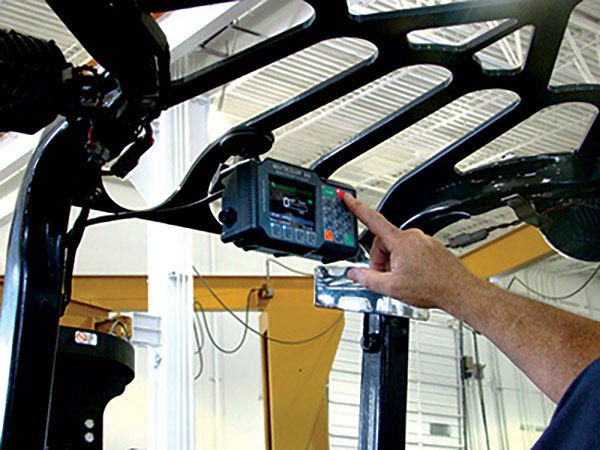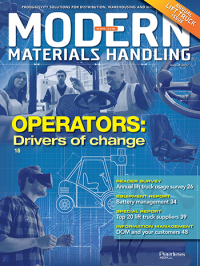Leveraging Your Lift Truck Data
Embracing the data-driven culture in today’s DCs and warehouses could pay off for your facility—large or small.
Focused on running efficiently while providing consistent services and improving the customer experience, facilities are increasingly turning to metrics, data and key performance indicators (KPIs) to help them achieve those goals. In the warehouse or DC, for example, data has become a focal point for any company that wants to become more accountable, make better decisions and keep tabs on its operations.
An important part of any warehouse operation, forklift fleets—no matter how big or small—are more easily managed when data is involved. From impact data to fault codes to maintenance monitoring, data can help facilities track metrics and then use that information to make better decisions, and eke the most out of their investments.
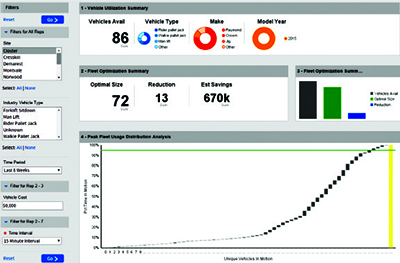
Whether they use a telematics system (i.e., one that monitors the location, status, movement and behavior of a forklift) or a fleet management solution, companies can access information about their fleets in a centralized location.
Some of the key lift truck data points that companies of all sizes are tracking include:
- checklists of daily completions,
- checklists of daily failures,
- short- and long-term impacts or accidents,
- fault codes/diagnostic trouble codes,
- maintenance monitoring,
- battery monitoring,
- lockouts (when vehicles lock out because of impacts or maintenance problems),
- driver certifications, and
- communication losses (when a lift truck loses its wireless connection).
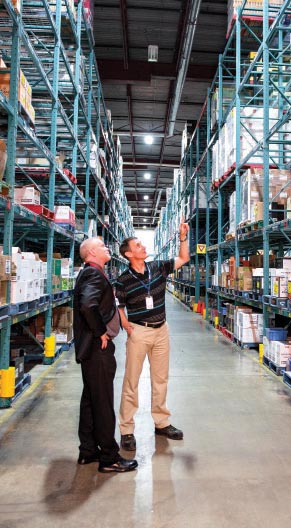 These and other data points can help minimize accidents, identify the best (and worst) operators, optimize vehicle investments, and more quickly identify and mitigate problem areas. The good news, says John Rosenberger, product/program manager for iWarehouse Gateway & Global Telematics at The Raymond Corp., is that even the smallest, most unsophisticated fleet can benefit from disciplined data collection.
These and other data points can help minimize accidents, identify the best (and worst) operators, optimize vehicle investments, and more quickly identify and mitigate problem areas. The good news, says John Rosenberger, product/program manager for iWarehouse Gateway & Global Telematics at The Raymond Corp., is that even the smallest, most unsophisticated fleet can benefit from disciplined data collection.
“All companies collect data on profit and loss, return on investment, and other key metrics that ensure that their businesses stay afloat,” says Rosenberger. “It’s the same with telematics. You want to know where you are in able to make better, fact-based decisions in the future—rather than just going by gut feel.”
Cheaper software and devices have also put lift truck data within reach of smaller firms that need data collection and device monitoring software and/or equipment. “Even firms that have small fleets can get great, entry-level functionality,” says Rosenberger, who uses an auto manufacturing analogy to describe this new level of accessibility. “A few years ago, it was a big deal to have a car with a back-up camera,” he explains. “Then manufacturers realized that they could put them on all cars—from the highest end to the low end. It’s the same with telematics, which are becoming less expensive but improving in terms of functionality.”
Who’s the better driver?
Terry Wickman, president at Keytroller, says facilities that are still using manual processes to track their lift truck fleets are doing themselves a disservice on several fronts. In fact, there are many areas where these companies could be leveraging data to work smarter, better and faster. For example, the company that has five forklifts operating on a daily basis in a warehouse may or may not have accurate accident logs. Or, those logs may be housed on a spreadsheet on someone’s computer and not accessible at a moment’s notice (for example, for an OSHA inspection).
“If someone has an accident, the first thing the OSHA rep is going to ask for is a checklist,” says Wickman, “because if someone got hurt on a vehicle that wasn’t operating properly, there could be some significant liability.” Wickman says basic fleet management programs may even lack a “checklist” capability, which means the companies using them are effectively out of compliance with OSHA and other regulations.
“The larger fleets generally understand that and are doing their logs electronically,” Wickman points out. “This goes to show that there’s still a big difference in the fleet size in terms of how interested [companies] are in this technology.”
In another example, Wickman says assessing lift truck impacts and speeding is straightforward with a telematics system, which will compare the number of hours an operator spends on a vehicle versus the number of impacts that he’s had during that time. If one forklift driver has seven impacts in a 500-hour period, and another has only had two impacts but within a 10-hour period, then who’s the safer operator? In this scenario, the element of time is very important, but can be easily overlooked in the absence of a good data management platform.
“On the surface, it looks like the second driver is safer because he’s had just two impacts,” Wickman explains. “In reality, the one who has seven impacts within 500 hours is the safer operator, but this isn’t always readily obvious when you’re using a manual or unsophisticated fleet management approach.”
Putting safety first
As more companies wrap their arms around the data being produced by their operations on a daily basis, some are realizing a few “side benefits” of their actions. In the DC, for example, knowing the fine details of vehicle operations, driver habits and accidents can help companies avoid potential OSHA fines and penalties.
Digging down deeper, Dan Romary, vice president of analytics and software at ID Systems, points out that a quick Google search can find a recent OSHA study that says more than 35,000 forklift-related accidents happen every year. In addition, 85 deaths and 62,000 non-serious accidents are attributed to lift trucks annually. “One of the key appeals for a smaller fleet is safety visibility,” says Romary.
Put simply, knowing when vehicles hit each other—or when they bump into other vehicles, assets or people—provides a level of visibility companies can use to their advantage. “Sites of all sizes are sensitive to safety-related costs,” says Romary, “whether that means damage to vehicles, inventory, facilities or people. It all matters.”
What also matters is operator authorization—or, knowing that the forklift drivers themselves are authorized to use the vehicles, and that “not just anyone” can jump in, fire up the engine and drive around. Romary says telematics platforms help ensure this doesn’t happen and that usage is limited only to authorized operators.
“This really helps companies enforce some certified operator standards,” says Romary, “and it really speaks to data’s role in improving safety, adhering to standards and meeting mandates.”
Saving money
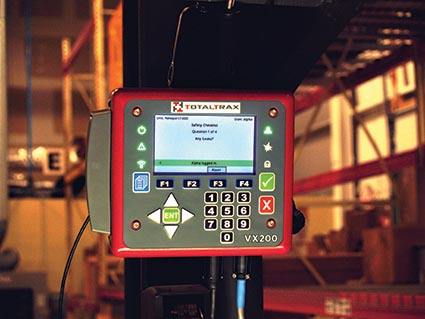 The data-driven warehouse or DC may also be able to save a few bucks on insurance premiums.
The data-driven warehouse or DC may also be able to save a few bucks on insurance premiums.
“Companies may also get reduced premiums on their workman’s compensation and business insurances, as well as loss avoidance on product, property and injury [coverage],” says Richard Sorenson, director of product management at TotalTrax.
“Workman’s comp, for example, factors the Experienced Modification Rate (used to gauge past cost of injuries and future chances of risk) into the computation of premiums,” Sorenson adds. (The lower the business’ EMR is—a point that can be proven by the warehouse or DC that’s using reliable data—the lower the company’s worker’s compensation insurance premiums.)
“More and more insurance companies are looking to these types of systems to determine their rates,” says Sorensen, who sees this as a particularly sore point for smaller firms that aren’t using fleet management systems. “[Higher] premiums can impact small businesses that really don’t have the depth and cash flow to absorb such impact, particularly for product and injury losses.”
Taking that first step
With all of the emphasis that’s being placed on the need to gather, store, manipulate and review the piles of data that companies continue to generate, it’s easy to lose sight of the “actionable” quality of this information and overlook the value it can provide. Within the warehouse or DC, where the need to extinguish daily fires can usurp any good data management plan, a good starting point often lies in a simple question: What is our current fleet management approach costing us?
“Before you get mired in the data and forget what you’re even looking at, figure out how much your fleet costs to operate,” advises Jim Gaskell, director of global technology and business development at Crown Equipment Corp.
In most cases, Gaskell says, service providers can supply the associated data in a concise manner, since they’re collecting the data and invoicing according to those metrics. “Trying to get inside your own system and figure out your costs according to what you paid is more difficult,” he says, “and namely because you don’t always know the exact detail behind the [charges].”
Once the information is gathered, Gaskell says the next step is to establish current benchmarks (Where are we at today? What are our costs?), and then compare them to how other companies are doing. “Ask your service provider how you compare to the other companies that it’s working with in terms of cost-per-hour (or, gather your own intelligence from companies in your industry),” says Gaskell, “and then use that information to pull all of your costs together and figure out a plan of action for improvement.”
Companies mentioned in this article

Article Topics
Lift Trucks News & Resources
BSLBATT is looking for new distributors and resellers worldwide Hyster recognizes Dealers of Distinction for 2023 Carolina Handling names Joe Perkins as COO Toyota Material Handling North America appoints Mark Taggart as CFO Learn from lift truck service history Toyota Material Handling honors its top forklift dealers in North America Fleet Team expands with strategic acquisition of Forklift Training Systems More Lift TrucksLatest in Materials Handling
Registration open for Pack Expo International 2024 Walmart chooses Swisslog AS/RS and software for third milk processing facility NetLogistik partners with Vuzix subsidiary Moviynt to offer mobility solutions for warehouses Materials Handling Robotics: The new world of heterogeneous robotic integration BSLBATT is looking for new distributors and resellers worldwide Lucas Watson appointed CSO for Körber’s Parcel Logistics business in North America Hyster recognizes Dealers of Distinction for 2023 More Materials HandlingAbout the Author
Subscribe to Materials Handling Magazine

Find out what the world's most innovative companies are doing to improve productivity in their plants and distribution centers.
Start your FREE subscription today.
April 2024 Modern Materials Handling

Latest Resources


